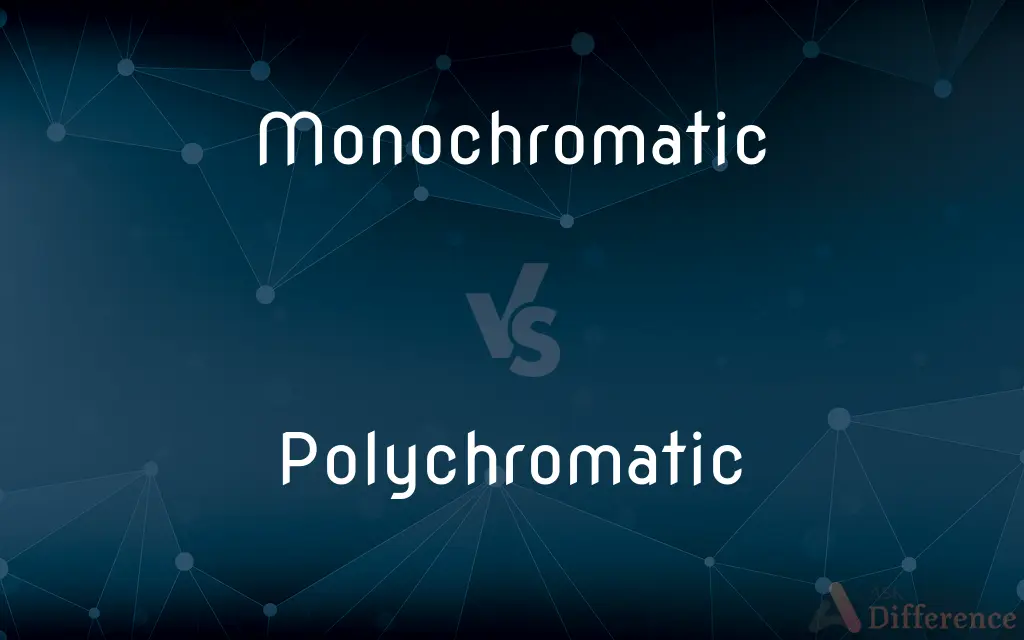Monochromatic vs. Polychromatic — What's the Difference?
By Tayyaba Rehman & Urooj Arif — Updated on April 3, 2024
Monochromatic light consists of a single wavelength, offering pure color and coherence, while polychromatic light contains multiple wavelengths, resulting in a spectrum of colors.

Difference Between Monochromatic and Polychromatic
Table of Contents
ADVERTISEMENT
Key Differences
Monochromatic light is characterized by a single wavelength, which means it is of one color or hue. This simplicity allows for applications that require high levels of precision and coherence, such as in laser technology and optical fiber communication. On the other hand, polychromatic light comprises a mix of multiple wavelengths, which translates to a blend of colors. This diversity is seen in everyday light sources like the sun, which emits a wide spectrum of light visible to the human eye.
In terms of applications, monochromatic light is crucial in scientific and medical fields, especially in spectroscopy and laser therapies, where specific wavelengths are required to achieve desired effects or measurements. Polychromatic light, with its variety of wavelengths, is essential for full-color imaging and photography, where capturing the richness and depth of scenes is necessary.
The concept of coherence is another differentiator. Monochromatic light sources can produce coherent light, where waves are in phase with each other, leading to the capability to focus sharply and maintain intensity over distance. Polychromatic light, due to its varied wavelengths, generally lacks coherence, which results in diffuse and unfocused light propagation.
In terms of visual perception, monochromatic light can create images with a single hue, limiting the differentiation of details based on color but allowing for variations in intensity and brightness. Polychromatic light enables the full-color perception that humans experience, allowing for the distinction of objects based on their color, which is vital for tasks like identifying ripe fruits or evaluating art.
The generation of monochromatic light often involves filtration or emission processes that isolate a specific wavelength, such as lasers or LEDs of a single color. Generating polychromatic light is inherently simpler, as it involves the use of broad-spectrum light sources like incandescent bulbs or natural daylight, which naturally emit light across a wide range of wavelengths.
ADVERTISEMENT
Comparison Chart
Wavelength
Single wavelength
Multiple wavelengths
Color
One color or hue
Spectrum of colors
Applications
Laser technology, spectroscopy
Full-color imaging, photography
Coherence
High coherence
Generally lacks coherence
Visual Perception
Images in a single hue
Full-color perception
Generation
Filtration or emission of specific light
Broad-spectrum sources like incandescent bulbs
Use in Communication
Optical fiber communication
Not directly applicable
Compare with Definitions
Monochromatic
Light of a single wavelength and therefore of one color.
The laser emitted a monochromatic beam of red light, perfect for the experiment.
Polychromatic
Describing light that contains a broad spectrum of colors.
Natural daylight is inherently polychromatic, enriching our visual experience.
Monochromatic
A design or image in varying shades of a single color.
The artist's monochromatic blue painting conveyed a sense of calm.
Polychromatic
Consisting of multiple wavelengths, resulting in various colors.
The polychromatic light from the prism spread a rainbow across the room.
Monochromatic
A description of light or other radiation with a very narrow bandwidth.
Monochromatic light in optical experiments reduces noise and increases accuracy.
Polychromatic
Pertaining to or involving several different wavelengths of light.
Polychromatic illumination is crucial for capturing true-to-life photographs.
Monochromatic
Pertaining to radiation of a single frequency.
Monochromatic radiation in the laboratory is essential for precise measurements.
Polychromatic
A term used in art and design to describe the use of multiple colors.
Her polychromatic dress was vibrant, reflecting her lively personality.
Monochromatic
A system or mode of communication using a single frequency.
The monochromatic signal was used for highly specialized communication tasks.
Polychromatic
Relating to the production or use of a spectrum of light.
The polychromatic spectrum analysis helped in identifying the substance.
Monochromatic
Having or appearing to have only one color.
Polychromatic
Having or exhibiting many colors.
Monochromatic
Of or composed of radiation of only one wavelength
Monochromatic light.
Polychromatic
Of or composed of radiation of more than one wavelength
Polychromatic light.
Monochromatic
Done in monochrome
Monochromatic paintings.
Polychromatic
Showing a variety, or a change, of colours; having many colours; multicoloured.
Monochromatic
Exhibiting monochromatism.
Polychromatic
Composed of more than one wavelength.
Monochromatic
Unvarying or dull
"the more prosaic and monochromatic aspects of communist life" (Amy Tan).
Polychromatic
Showing a variety, or a change, of colors.
Monochromatic
Having only one color, represented by differing hues and tints. For example shades in a black and white television.
Polychromatic
(of light or other electromagnetic radiation) composed of more than one wavelength;
Polychromatic light
Monochromatic
Perceptive of only one color; unable to distinguish colors; total color blindness.
Polychromatic
Having or exhibiting many colors
Monochromatic
(figuratively) Plain, dull, lifeless.
Monochromatic
Consisting of one color, or presenting rays of light of one color only.
Monochromatic
Of or relating to monochromatism
Monochromatic
(of light or other electromagnetic radiation) having only one wavelength;
Monochromatic light
Monochromatic
Having or appearing to have only one color
Common Curiosities
How does polychromatic light enhance visual perception?
It enables the human eye to see a full spectrum of colors, enhancing detail and depth perception.
Can polychromatic light be focused as sharply as monochromatic light?
Generally, no, because its varied wavelengths reduce coherence and focusing capability.
Can monochromatic light create color images?
No, it produces images with shades of only one color, lacking the full color spectrum.
What makes light monochromatic?
Light that consists of one wavelength or color, often produced by lasers or specific LEDS.
How is polychromatic light created?
It naturally occurs in many light sources like the sun or can be produced by incandescent bulbs.
How does monochromatic light affect artistic representations?
It limits the palette to shades of one color, often used for stylistic or thematic reasons.
What role does polychromatic light play in photography?
It's essential for capturing the full color and vibrancy of scenes.
Why is monochromatic light important in spectroscopy?
It allows for the identification and analysis of substances based on their absorption of specific wavelengths.
Is natural sunlight monochromatic or polychromatic?
Polychromatic, as it includes a broad range of wavelengths.
Are all lasers monochromatic?
Most lasers emit monochromatic light, but some specialized lasers can produce polychromatic beams.
What is monochromatic light used for?
It's used in applications requiring precise control, like lasers and fiber optics.
Can polychromatic light be used in laser technology?
Lasers typically use monochromatic light for precision, but polychromatic lasers exist for specific applications like imaging.
What is the advantage of using monochromatic light in optical communication?
It minimizes interference and allows for clearer signal transmission over long distances.
Can you convert polychromatic light to monochromatic light?
Yes, through filtration or diffraction methods that isolate specific wavelengths.
Why is polychromatic light preferred in everyday lighting?
It provides a more natural and pleasant lighting experience, closely resembling sunlight.
Share Your Discovery

Previous Comparison
Modification vs. Adaptation
Next Comparison
Grass vs. HerbAuthor Spotlight
Written by
Tayyaba RehmanTayyaba Rehman is a distinguished writer, currently serving as a primary contributor to askdifference.com. As a researcher in semantics and etymology, Tayyaba's passion for the complexity of languages and their distinctions has found a perfect home on the platform. Tayyaba delves into the intricacies of language, distinguishing between commonly confused words and phrases, thereby providing clarity for readers worldwide.
Co-written by
Urooj ArifUrooj is a skilled content writer at Ask Difference, known for her exceptional ability to simplify complex topics into engaging and informative content. With a passion for research and a flair for clear, concise writing, she consistently delivers articles that resonate with our diverse audience.















































